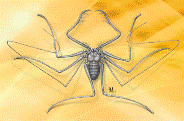Papers in the Biological Sciences
Document Type
Article
Date of this Version
January 2007
Abstract
Morphological modifications of the first pair of legs in addition to widespread color variations of these legs among males of closely related species have been reported in a variety of spiders. Here, the evidence for sexual dimorphism in male foreleg morphology within wolf spiders (family Lycosidae) is reviewed and shown to occur in a number of species belonging to at least seven genera in five subfamilies: Alopecosa, Hogna, Schizocosa (all Lycosinae) Pirata (Piratinae), Evippa, (Evippinae), Pardosa (Pardosinae) and Artoria (Artoriinae). These modifications, often in combination with distinct dark pigmentation, can be divided into three major groups: leg elongation, segment swelling and exaggerated setation (“brushes”). The latter two occur mainly on the tibial segment of the first leg. The function of these foreleg modifications has been studied most extensively in the genus Schizocosa. Since the courtship displays of all male Schizocosa incorporate a seismic component, foreleg ornamentation (namely pigmentation and associated “brushes”) composes only one part of a multimodal courtship display. The function of this foreleg ornamentation appears to vary across closely related Schizocosa species and in some instances involves an interaction with the seismic signaling component. In most instances it appears to play a role in female mate choice and/or mate choice learning. In addition to reviewing lycosid foreleg modifications, we describe a new species of wolf spider, Artoria schizocoides from southwestern Western Australia that possesses sexually dimorphic modifications of the tibia of the first leg. Unique within the Artoriinae, males of this species carry spatulate setae on the ventral side of the tibia of the first leg that differ morphologically from other leg modifications in wolf spiders.


Comments
Published in The Journal of Arachnology 35:89–101. Copyright © American Arachnological Society. Used by permission.